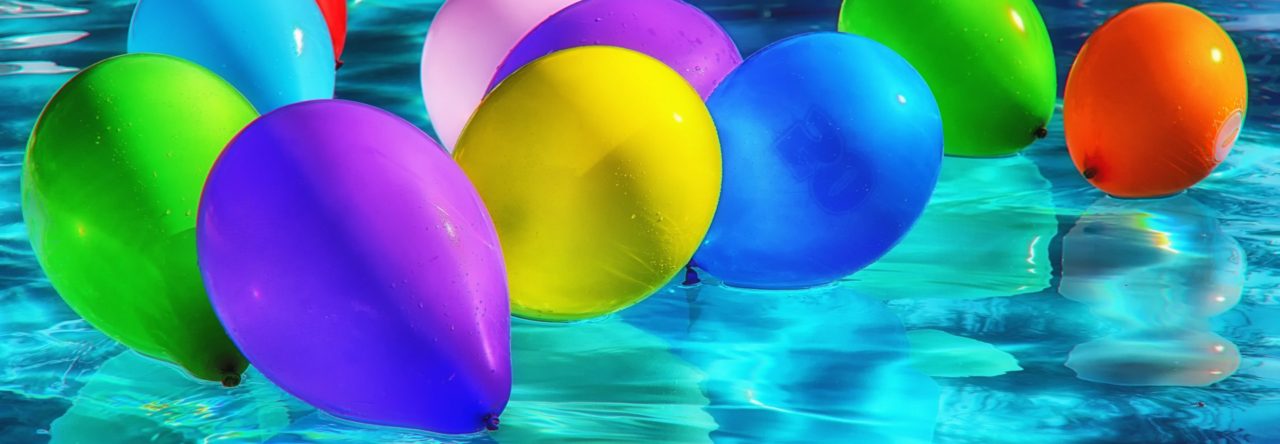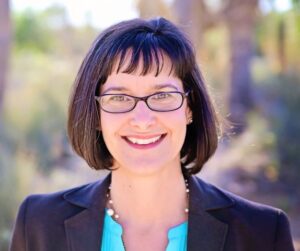 This month’s Author Interview is with Kirsten Larson, a Los Angeles writer who “writes books for curious kids.” Not only has she published a number of fine nonfiction picture books, but she’s also created a middle grade graphic nonfiction book and more than two dozen books for the school and library market.
This month’s Author Interview is with Kirsten Larson, a Los Angeles writer who “writes books for curious kids.” Not only has she published a number of fine nonfiction picture books, but she’s also created a middle grade graphic nonfiction book and more than two dozen books for the school and library market.
In addition to all of her writing, Kirsten teaches at The Writing Barn and serves as a “nonfiction and query corner ‘elf’” for Julie Hedlund’s popular 12x12 Picture Book Writing Challenge. Kirsten’s also the proud owner of a house “filled with LEGOs, laughter, and lots of books.”
Let’s find out more about how Kirsten does all of this!
RVC: It’s strange to think how many interviews I’ve done for this blog with current and former rocket scientists, and you’re in the club, too. There’s probably a STEM joke in there somewhere…
KL: Actually, I’m not a rocket scientist, but I worked WITH rocket scientists at NASA.
RVC: For the purpose of jokemaking, I think that totally counts! But for factual reasons, what did you actually do there?
KL: I handled public relations for NASA’s Space Shuttle and International Space Station programs, as well as their aeronautics programs. It was great training for science storytelling through print, video, and photography as well as for working with news media.
RVC: What’s the most common misconception people have about rocket scientists?
KL: I think many people have a very Big Bang Theory/Sheldon Cooper perception of rocket scientists, as in they are so smart they don’t have a sense of humor or are almost robots. But most rocket scientists I’ve met are pretty regular people often with great senses of humor and a myriad of interests.
RVC: Now here’s the Saturn V‑sized question we’re all dying to know—how did yet another former NASA person begin writing picture books?
KL: My kids loved nonfiction books when they were little. At the public library, they’d pull books off the shelves about space, weather. Anything, really. As I read the books with them, I began to think I could probably write them, and would love an excuse to become a mini expert in all kinds of different topics.
RVC: Let’s talk about you the writer. What aspect of your writing life gives away where you’re from and how you were raised?
KL: I write about a lot of different things–art, history, science, engineering. My parents really encouraged a love of learning. My mom was a schoolteacher with shelves of picture books we all read together. And my parents had other shelves packed with mystery novels, poetry, Shakespeare, Russian literature, you name it. And then there was my grandmother with her full set of encyclopedias. I was encouraged to read whatever I wanted. There weren’t any limits. And I read everything.
RVC: Who are some of your kidlit world heroes?
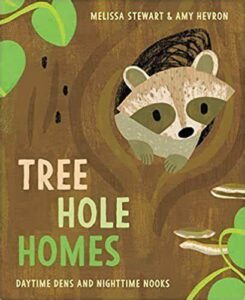 KL: I’m a big fan of Melissa Stewart. She has some of the best classroom resources around for teachers working with students on informational writing. And Melissa is such a champion of nonfiction for kids in general, which can get short shrift by teachers and librarians who often prefer fiction. I just read Melissa’s Tree Hole Homes–illustrated by Amy Hevron–which is excellent.
KL: I’m a big fan of Melissa Stewart. She has some of the best classroom resources around for teachers working with students on informational writing. And Melissa is such a champion of nonfiction for kids in general, which can get short shrift by teachers and librarians who often prefer fiction. I just read Melissa’s Tree Hole Homes–illustrated by Amy Hevron–which is excellent.
RVC: Let’s zero in on YOUR books. What’s the story behind your first published picture book?
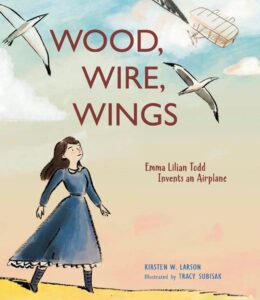 KL: My first picture book was Wood, Wire, Wings: Emma Lilian Todd Invents an Airplane, which is illustrated by Tracy Subisak (Calkins Creek). I learned about Lilian Todd through an illustration in the bestselling book Rosie Revere, Engineer by Andrea Beaty, illustrated by David Roberts. I have lived and worked around airplanes my whole life and had never heard of her! I made it my mission to make sure the world knew about her.
KL: My first picture book was Wood, Wire, Wings: Emma Lilian Todd Invents an Airplane, which is illustrated by Tracy Subisak (Calkins Creek). I learned about Lilian Todd through an illustration in the bestselling book Rosie Revere, Engineer by Andrea Beaty, illustrated by David Roberts. I have lived and worked around airplanes my whole life and had never heard of her! I made it my mission to make sure the world knew about her.
RVC: What’s the most useful lesson that book taught you?
KL: Writing is a lot like engineering. You write a draft. That’s your prototype. But then you test it with your critique group and tweak it to improve it. And failure is always part of the process. You have to persist.
RVC: What part of that book are you most proud of?
KL: I really learned how to write on that book, thanks to my editor, Carolyn Yoder. It took me a long time to figure out how to write emotionally resonant scenes, as well as the structure, which follows the engineering design process.
RVC: Please put the following in order.
- I wrote my first picture book.
- I got an agent.
- I started writing for the education market.
- I became a writing coach.
- I did a glorious interview with the much beloved picture-book blog, Only Picture Books.
KL:
- I wrote my first picture book.
- I started writing for the education market.
- I got an agent.
- I became a writing coach.
- I did a glorious interview with the much-beloved picture-book blog, Only Picture Books (which is obviously the pinnacle of my career! )
RVC: Love it! Now, in retrospect, would you have done it differently if you could’ve changed the order?
KL: You mean, besides speeding up the whole process from writing my first picture book to getting an agent, which took four years? Just kidding. I’m pretty happy with the way things went.
RVC: How did getting an agent affect your writing career?
KL: I think it’s really tough to work without an agent in today’s market. Fewer and fewer publishers take unsolicited submissions. So, aside from being able to sell work, working with Lara (Perkins of Andrea Brown Literary Agency) has made me a better writer for sure.
RVC: What’s Lara’s agenting superpower?
KL: She’s the right type of editorial agent for me, always asking the right questions or helping me brainstorm, so I can create the books I envision. And she’s great at encouraging me not to give up when I take on hard things and then try to backtrack.
RVC: What would Lara say is your writing superpower?
KL: My superpower is a willingness to completely reimagine manuscripts. We’re talking complete restructuring of a picture book or accepting a challenge to turn a picture book into a graphic novel script. On the latest picture book I’m working on, I tossed out everything but the title. And I’ve done that several times with this particular book.
RVC: I notice that you enjoy using alliteration, even though you’re primarily writing nonfiction picture books vs, say, humorous poetry or read-a-loud fiction.
KL: I learned a lot about writing lyrically from Renee LaTulippe of the Lyrical Language Lab. You can punch up any prose with poetic techniques, making it more musical and fun to read.
RVC: What’s your best tip for creating effective alliteration?
KL: My alliteration secret weapon is the Thesaurus.com. Maybe I’ve written that the bee is flying. I can look up synonyms for fly and come up with “the bee buzzes,” for example. My other biggest tip is not to overdo the alliteration, or you might find your reader tripping over the words.
RVC: You write a lot of picture book nonfiction, and not just for the educational market. Why are you so drawn to those?
KL: As you know, picture books take a LONG time, even before you sell them to a publisher. It’s so important to pick stories you are passionate about and don’t mind coming back to over and over again in revision. I have more stamina when it comes to writing nonfiction. I care more deeply about sharing those stories, and I feel more invested in getting them right.
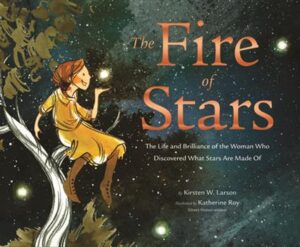 RVC: You’ve got a new picture book coming out this month—The Fire of Stars: The Life and Brilliance of the Woman Who Discovered What Stars Are Made Of. What’s the elevator pitch?
RVC: You’ve got a new picture book coming out this month—The Fire of Stars: The Life and Brilliance of the Woman Who Discovered What Stars Are Made Of. What’s the elevator pitch?
KL: Astronomer and astrophysicist Cecilia Payne was the first person to discover what burns at the heart of stars. This lyrical picture book biography powerfully parallels the kindling of Cecilia Payne’s own curiosity and her scientific career with the process of a star’s birth, from mere possibility in an expanse of space to an eventual, breathtaking explosion of light.
RVC: Picture books in general, but nonfiction ones in specifics, are all about trimming, trimming, trimming, even though the initial material is often so darn great (and often 5x the length of any sensible picture book). Given that sobering editorial reality, what terrific thing didn’t make it into the final iteration of the new book?
KL: Um, Cecilia Payne’s entire career? The book ends with Cecilia’s discovery that stars are mostly hydrogen and helium. She was 25, and it was her dissertation. She wasn’t even employed as an astronomer yet! But Cecilia’s pursuit of the thrill of discovery was what the book was about. So I had to move so much to the timeline in the back matter, including all her work as an astronomer at Harvard where she eventually became the first woman to serve as head of the Astronomy Department (in 1956, 21 years later!)
RVC: I rarely ask people questions about writing coaching, so I’m going to remedy that right now. What made you choose to become a writing coach?
KL: Even before I began to teach nonfiction writing, people would ask if I did manuscript critiques, but I always declined. Finally, I decided the universe was trying to tell me something, and maybe I did have something to offer my fellow writers. I take a very collaborative approach, trying to help writers achieve their vision for the story and tuning into why the story is so important for them to tell.
RVC: In all of your experience as a writing coach, what has surprised you the most?
KL: I’m always surprised at how it’s far easier to help clients diagnose and fix their manuscripts, but so difficult to see my own work clearly. When your heart is on the page, it’s tough to take a step back and look at the work objectively and ask if it’s achieving what you want it to achieve.
RVC: What’s the best advice you’d give to someone considering hiring a writing coach to help them break into the picture book marketplace?
KL: First, I would say that most of the time, you don’t need to pay a book coach or editor before submitting your picture book to agents or editors. Most people don’t. I think coaches can be helpful when you’ve exhausted your resources, like your critique partners for example, and you are stuck and need a fresh set of eyes. But people also need to remember, hiring a coach isn’t magic. Getting a book published is part luck and timing too, not just great writing. If I knew exactly what would sell at any point in time, I’d have dozens of books under contract.
RVC: One final question for this part of the interview, Kirsten. It’s brag time! What projects do you have on the NASA launch pad beyond The Fire of Stars?
KL: I have two upcoming projects that I’m able to share. I have the graphic novel The Light of Resistance, illustrated by Barbara McClintock (Roaring Brook), the true story of Rose Valland, a French curator turned spy who saved countless precious art works from the Nazis. My next picture book is This Is How You Know, illustrated by Cornelia Li (Little, Brown), a lyrical love letter to science.
RVC: Alrighty! It’s now time for the NASA-rocketship-fast SPEED ROUND. Let’s begin with an old black-and-white science fiction film countdown to create some delicious drama.
THREE…
TWO…
ONE…
BLAST OFF!!!!
RVC: If you could only have one app on your phone, it’d be…
KL: Oh, geez. I’ll go with Libby, the library app. I was never a big ebook reader before March 2020. But when libraries shut down, Libby was the only way I could get new books at first. And I learned I loved eBooks (for reading novels, not picture books). I put books on hold and can check them out as they become available or ask the library to come back to me if I’m not ready yet. And I don’t lose my place in line. Plus, how handy is it to have a book in your back pocket or purse at all times for those moments you’re stuck in a long check-out line?
RVC: What animal or plant should be renamed?
KL: Naked mole rats are neither moles nor rats. Who came up with this name? Interestingly, they are the only eusocial mammals, operating much like honeybees do in their hive.
The naked mole rat shall henceforth be known as HivePup. These guys totally deserve some love.
RVC: If you had a NASA rocket that you wanted to hide, where would you stash it?
KL: Definitely in the back of a giant refrigerator. Based on my experiences with my family, no one would ever move things around and find it. (They tease me that my response to all their “Where is?” questions is, “You have to move some things around.”)
RVC: What are five things you couldn’t do your writing without?
KL: Coffee. Books–and not just for research. I am a big advocate for using books in your category and genre as mentor texts. The internet–I am always amazed at the things I can now get online that I had to read on microfiche 20 years ago. My Macbook–I cannot write on a phone or iPad. Journal–I’m a visual writer, and I often thumbnail out the structure of books spread by spread, especially when revising.
RVC: Who sets the standard for writing STEM picture books?
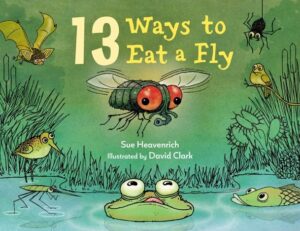 KL: Rather than pointing out someone who sets the standard, I want to point out the diversity in STEM storytelling these days, which is so amazing. We are really in a golden age of STEM books. You have STEM books showcasing neurodiversity (like Jen Malia’s Too Sticky!) and cultural traditions (like Rajani LaRocca’s Bracelets for Bina’s Brothers). Funny books like Sue Heavenrich’s 13 Ways to Eat a Fly. And lovely, lyrical books like Be a Tree by Maria Gianferrari. There is truly something for everyone.
KL: Rather than pointing out someone who sets the standard, I want to point out the diversity in STEM storytelling these days, which is so amazing. We are really in a golden age of STEM books. You have STEM books showcasing neurodiversity (like Jen Malia’s Too Sticky!) and cultural traditions (like Rajani LaRocca’s Bracelets for Bina’s Brothers). Funny books like Sue Heavenrich’s 13 Ways to Eat a Fly. And lovely, lyrical books like Be a Tree by Maria Gianferrari. There is truly something for everyone.
RVC: What’s the best compliment a child ever gave your writing?
KL: One of my favorite thank you notes had this riddle: “What do you call a great book? WOOD, WIRE, WINGS!” Kids are so clever.
RVC: Thanks so much, Kirsten!

